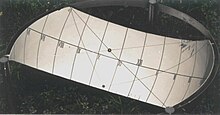Nodus (sundial)
Nodus (Latin for knot ; also used in botany and medicine) refers to the smallest possible, almost punctiform device on a sundial , with the help of which the sun is depicted on the dial in a central projection. The use of this term is derived from pole rod sundials, on the pole rod of which a knot-like thickening was attached to enable the central projection of the sun in addition to the linear rod projection.
In other languages, the term nodus is used more consistently for sundials than in German. It is defined in a glossary of the US Planetary Society. It summarizes the older, object-oriented terms such as shadow-throwing point and gnomon point . According to the principle - projection of the position of the sun through a point on the sundial dial - the hole gnomon ( aperture plate ) used in the eye sundial is also a nodus .
With the shadow or light point generated by the Nodus , additional information that is not contained in the shadow or light line of the pole rod can be displayed. The sun is depicted in two dimensions .
Individual evidence
- ↑ American Planetary Society: Glossary: Feature on a gnomon that allows viewers to see the shadow of a single point, as opposed to that of a post or edge. A mode often enables the dial to tell the date as well as the time. [1]
- ↑ Helmut Sonderegger: Date lines on sundials (Der Schattenweg des Nodus) , Austrian Astronomical Association, Working Group Sundials, Circular No. 36, 2008
